
RESPONDING TO
COMPLAINTS &
CONCERNS:
A Letter Writing Guide
for Healthcare Providers
and Administrators
January 2017

March 2017
Healthcare Insurance Reciprocal of Canada
www.hiroc.com
Head Ofce
4711 Yonge St, Suite 1600
Toronto, Ontario M2N 6K8
Tel: 416.733.2773
Toll Free: 1.800.465.7357
Western Region
1200 Rothesay St.
Winnipeg, Manitoba R2G 1T7
Tel: 204.943.4125
Toll Free: 1.800.442.7751
westernregion@hiroc.com
Disclaimer/Terms of Use: This is a resource for quality assurance and risk management purposes and is not
intended to provide legal or medical advice. Every effort has been made to ensure that the information is
accurate at time of publication.

TABLE OF CONTENTS
Foreword from HIROC
3
Introduction
4
When things go wrong
4
Why individuals complain
5
Four easy steps to putting things right when a complaint is received
6
The complaint response letter layout
7
Keep these tips in mind
8
Sample statements for the complaint/concern response letter
9
Writing the complaint/concern response letter
11
Writing the complaint/concern response letter to a challenging individual
17
Final thoughts
17
Additional Resources
18

Foreword
from HIROC
For the majority of healthcare recipients,
their experience of the care and service
you provide is positive and appreciated.
But when things go wrong and
dissatisfaction or unmet expectations
result, how people and organizations
respond determines not just how the
individual will feel, but says a lot about
your organization’s culture. Responding
to complaints and concerns is an
opportunity to acknowledge the incident
and learn from what went wrong.
This guide is written for all types and
sizes of healthcare organizations and
provides useful and practical information
about writing effective response
letters. Taking steps to improve how
your organization responds in writing
to complaints shows patients/clients,
families and staff that you are always
open to feedback and improvement.
Please bear in mind as you read this
guide that it is important to comply
with any applicable privacy legislation
throughout the process of considering
and responding to a complaint.
3

Written
responses to
complaints
are producible
in legal
proceedings.
They should be
drafted with
the assumption
they could
appear in a
courtroom,
be posted on
social media or
appear on the
front page of
the newspaper.
Introduction
We know your organization does more things right than wrong. But when things do go wrong and there
are misunderstandings, a response is required. From our work with providers of healthcare, we know how
important listening and learning is to safe, considerate and appropriate care. It is also a critical way to avoid
future problems.
Ideally, the best scenario is to meet with the person who has a complaint, but that is not always possible
or practical. With that in mind, we have created this guide to help you and your staff compose written
responses to the concerns of individuals. The information and tips will assist you in writing letters that are
not just perfunctory responses to complaints, but an indication of how your organization cultivates a culture
of openness and feedback. We hope you will nd this information useful.
We encourage the early involvement of your organization’s risk management personnel in this process.
HIROC’s Healthcare Risk Management Department is also available to provide assistance.
Please note references to “individual(s)” in this document encompass
anyone who receives health services across the continuum of care (e.g.
client, patient, family and resident).
When things go wrong
Jennifer White’s story relays the importance of thoughtful and
empathetic written responses to complaints. Having written a complaint
letter to the hospital about what she described as “attitude” from
some of the nursing staff during her post-operative stay, Jennifer was
extremely disappointed and dissatised with the dismissive tone of
the hospital’s response letter. There was neither an explanation nor
an apology mentioned leaving Jennifer with an unsettled feeling that
perhaps this type of behaviour was condoned at the hospital. A friend of
Jennifer’s shared a similar experience chalking it up to the overall culture
of the organization.
Davis Bannon’s experience was completely different from Jennifer’s
when he complained to the community care agency about difculties
he and his wife had encountered getting consistent service providers
in to care for his ventilator-dependant daughter. After several months
of frustration, Davis felt compelled to write a letter of complaint to
the agency. The response letter Davis received back was apologetic
and caring, leaving Davis with an immediate sense of relief. The letter
offered several solutions to alleviate the problem with clear timelines
for implementation. Davis was left with the sense that he had been
acknowledged and respected.
4
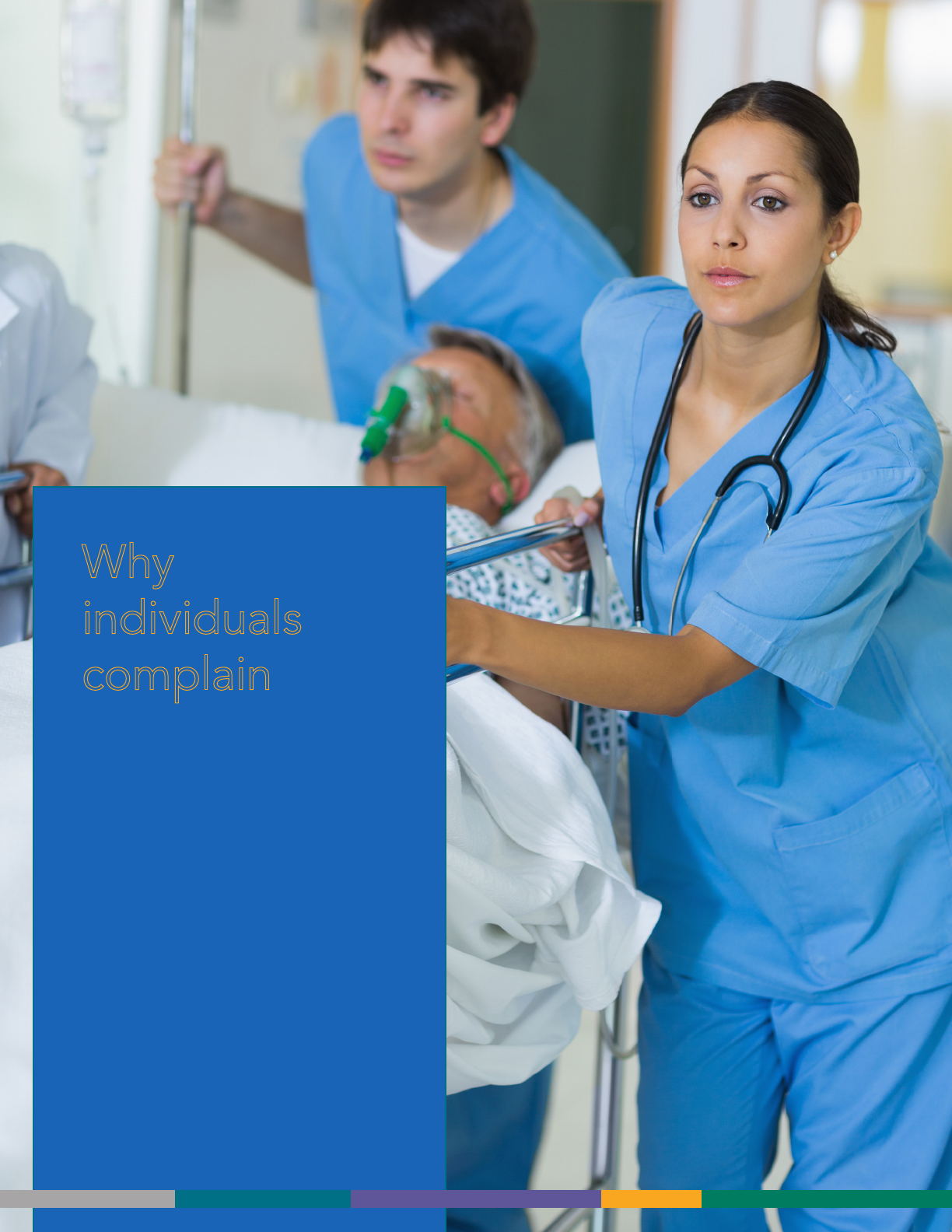
Why
individuals
complain
There are many reasons why individuals
complain to healthcare organizations.
They may:
• be seeking information about and/
or an apology for a negative or
unexpected outcome.
• want reassurance that action will be
taken to reduce the likelihood that
a similar incident will happen again.
• want someone to be held
accountable for what happened.
• want compensation for the
perceived harm.
No matter what the cause, unmet
expectations, poor communication and
a level of dissatisfaction are often at the
root of these complaints.
5

Early acknowledgement is pivotal in preventing a minor
concern from escalating into a formal complaint.
1. Acknowledge the
complaint as quickly
as possible. Adhere to
a response timeframe
(as outlined in an
organizational policy
or guideline) and
communicate when
the individual(s) can
expect to receive a
reply. Be mindful of
legislated response-time
requirements if these
exist in your province
or territory. Prolonging
a reply to a verbal or
written complaint/
concern, may erode
trust and antagonize
the individual. A timely
response informs
the individual the
organization has received
the information and
takes it seriously. If for
any reason, a delay in
responding is anticipated,
let the individual know
when he/she is most likely
to receive a reply.
2. Investigate.
Investigate to obtain facts
related to the subject
matter of the complaint
using documentation
(such as the health
record/incident report)
and/or discussing with
pertinent staff. And do
it quickly – memories
fade and people forget
crucial details. The scope
of the investigation
will vary depending on
the particulars of the
complaint. Remember
as you conduct the
investigation and prepare
a response that personal
health information
can only be disclosed
in accordance with
applicable privacy law.
3. Respond in person
or writing. Wherever
possible, invite
the individual who
brought the complaint/
concern forward to
have a conversation.
Writing a letter is not a
replacement for the face-
to-face meeting. While
not always practical, this
is optimal. In a face-to-
face meeting, you can
quickly establish what
the individual or family
is feeling and what
they see as a suitable
outcome, giving you
the opportunity to
appropriately respond to
the situation. If a face-
to-face meeting is not
possible – or desired
by the aggrieved party
– a written response
is essential. In fact,
many people will not
let the matter rest until
they receive a written
response.
4. Always follow-up
whether in person
or in writing. If the
matter can be resolved
immediately in-person
or over the phone, a
written response should
be sent as a follow-
up to summarize and
expand upon your prior
discussion and conrm
any agreed-upon
actions. Following up
makes individuals feel
appreciated rather than
ignored and that you are
interested in what they
had to say.
If a written response has
been sent in lieu of a
face-to-face meeting (not
possible/desired by the
aggrieved party), further
follow-up in writing is not
indicated.
3
1
Acknowledge
2
Investigate Respond
4
Follow-up
Four easy steps to putting things right
when a complaint letter is received:
6
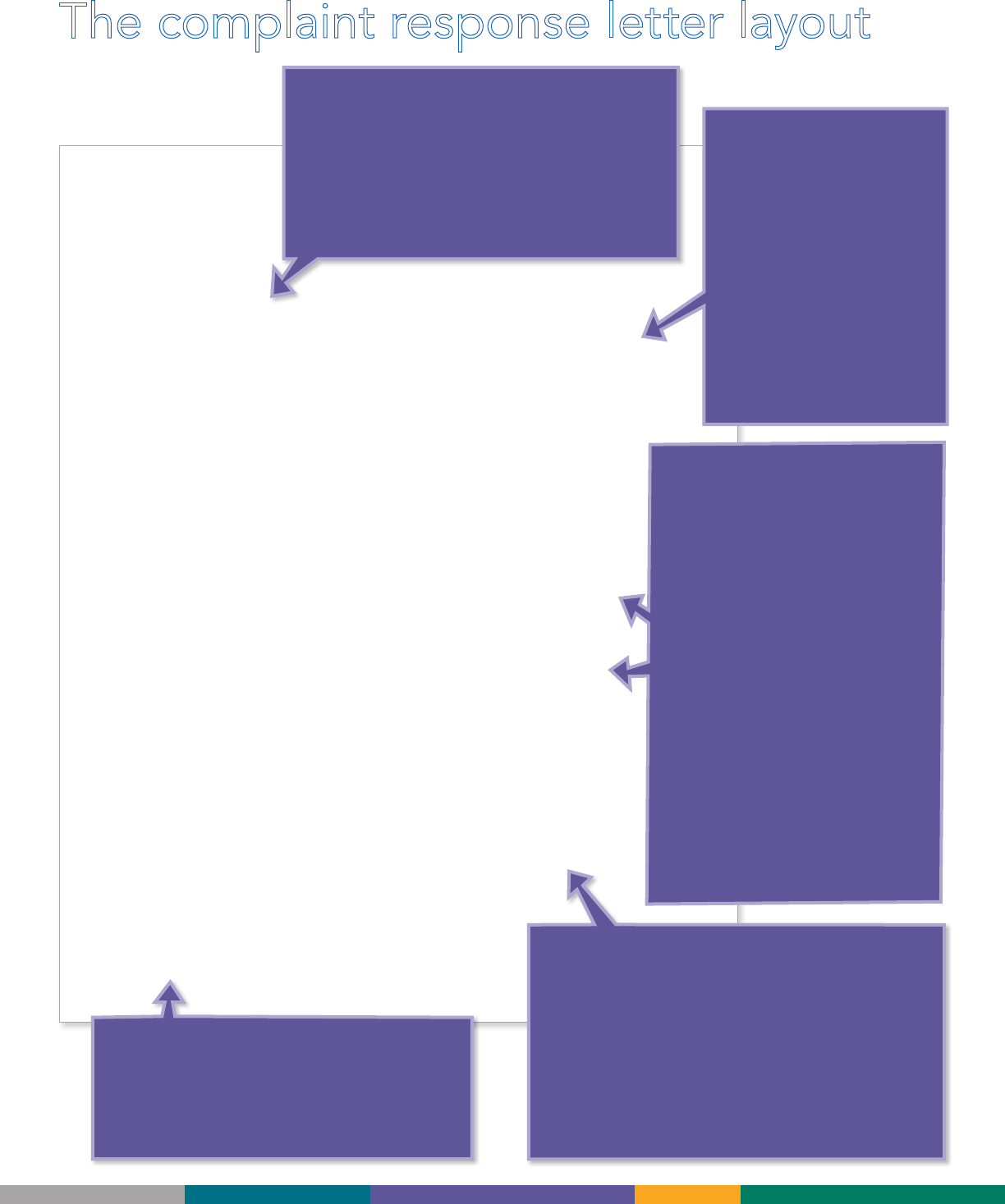
SAMPLE
May 20, 2016.
Dear Mrs. Smith
re: Recent visit to Emergency Department
ank you for your letter of May 10, 2016 regarding your recent experience
in our Emergency Department. Clearly our care did not meet your
expectations with a prolonged wait, lack of courtesy and lack of pain control
for your back pain. For your experience of all this, I do sincerely apologize.
I can understand how upsetting this has been for you.
I also want to assure you that we take these concerns very seriously and this
is not the patient/family experience we strive for. An investigation into this
matter included a review of your health record of May 7th and interviews
with the sta that took care of you. I have been advised that there were
several patients waiting for care that evening, some with life-threatening
conditions. Your prolonged wait to see the doctor related to that patient
volume and acuity on that particular shi. Reducing wait times for all
patients/families in our emergency department is a high priority at our
hospital and we anticipate improvements in future as we continue to address
this concern.
When the Emergency Department nurse manager spoke with the nurse
about her response to you, the nurse indicated she was regretful of her tone
with you and extends her sincere apologies for not addressing your pain
sooner.
If you have any further concerns about this and would like to discuss this in-
person with myself or the nurse manager, please contact me at the number
below and I will be happy to arrange a meeting for you. I am available
throughout the day and am happy to schedule a meeting with you.
Sincerely,
Lisa McDonald
Director, Patient/Family Relations
(Insert contact information)
The complaint response letter layout
1
The SALUTATION is a means
of courteous recognition and
is the opening of the letter.
Acknowledging the receipt of the
complaint/concern letter is part
of the salutation.
1
The
INTRODUCTORY
PARAGRAPH
should be concise
and clearly state
the purpose of
your letter. This
is where the
apology and/or
condolences are
expressed.
2
The MAIN BODY
of the letter should
include a paragraph
addressing each of the
key points you want
to make, what you
have learned from the
review and proposed
recommendations.
If there are several
complaints/concerns to
address, acknowledge
each one without
necessarily going into
a detailed analysis of
each.
3
The CONCLUDING PARAGRAPH
should include a nal expression of
regret and a concluding statement
providing an offer of further
follow-up phone calls or in-person
meetings and pertinent contact
information.
4
7
On your response letter, DO
NOT COPY all persons on the
complainant’s letter, unless
authorized by the complainant.
5

Be aware of privacy and condentiality issues.
Acknowledge receipt of the complaint (whether it
is by letter, email or phone) and address the chief
concern(s) stated by the individual.
If there is a request for compensation, consider
consulting HIROC or your organization’s legal
counsel.
Ensure each care theme identied in the
complaint letter is addressed in the apology
letter. If you do not have an answer, let them
know you will get back to them when you do have
the answer. Do not offer excuses. Be sincere, non-
adversarial and collaborative.
Avoid taking an explicit position that everything
was handled correctly. This is clearly not the
complainant’s experience.
Avoid referencing situations and/or care themes
not addressed in the complaint letter.
Use clear, concise and understandable language.
Avoid medical terms or put layman’s terms in
parentheses if necessary.
Do not use defensive language/phrasing – it
defeats the effort to ensure the complainant feels
valued and listened to. Avoid confrontation or
retort. Maintain a professional tone.
Acknowledge the writer’s distress.
Avoid long words, long sentences and long
paragraphs.
Do not patronize, minimize, negate or attempt
to correct the complainant’s experiences (“Your
letter indicated the nurse on call did not listen
to you when you mentioned that your mother
was experiencing a new type of stomach pain.
Our investigation does not substantiate this
occurrence.”).
If you are going to apologize, apologize upfront.
As per Canadian Patient Safety Institute (2011),
“An apology is a genuine expression of being
sorry for what has happened.” Make it personal –
use words such as “we” or “I”.
Do not comment on whether the standard of care
was breached or there was a lack of compliance
with healthcare organization policy/procedure/
guideline.
Do not address or include practitioner
performance issues in the written response. This is
a Professional Practice/Human Resource issue and
has no place in your response.
State that the complaints are being taken
seriously.
Re-establish trust – offer the results of a review.
Do not make promises that you may not keep.
Only address actions that have already or will be
taken to make improvements.
When discussing corrective measures/mitigation
strategies, stay at the system level versus
individual practitioner level.
Do not use policies and procedures as an excuse.
Keep these tips in mind as you
compose your letter
Certain condentiality
protections must be
respected depending
on the type of review
conducted. But, sharing
“lessons learned” and
what measures the
organization intends to
take to prevent future
incidents is generally
acceptable.
8
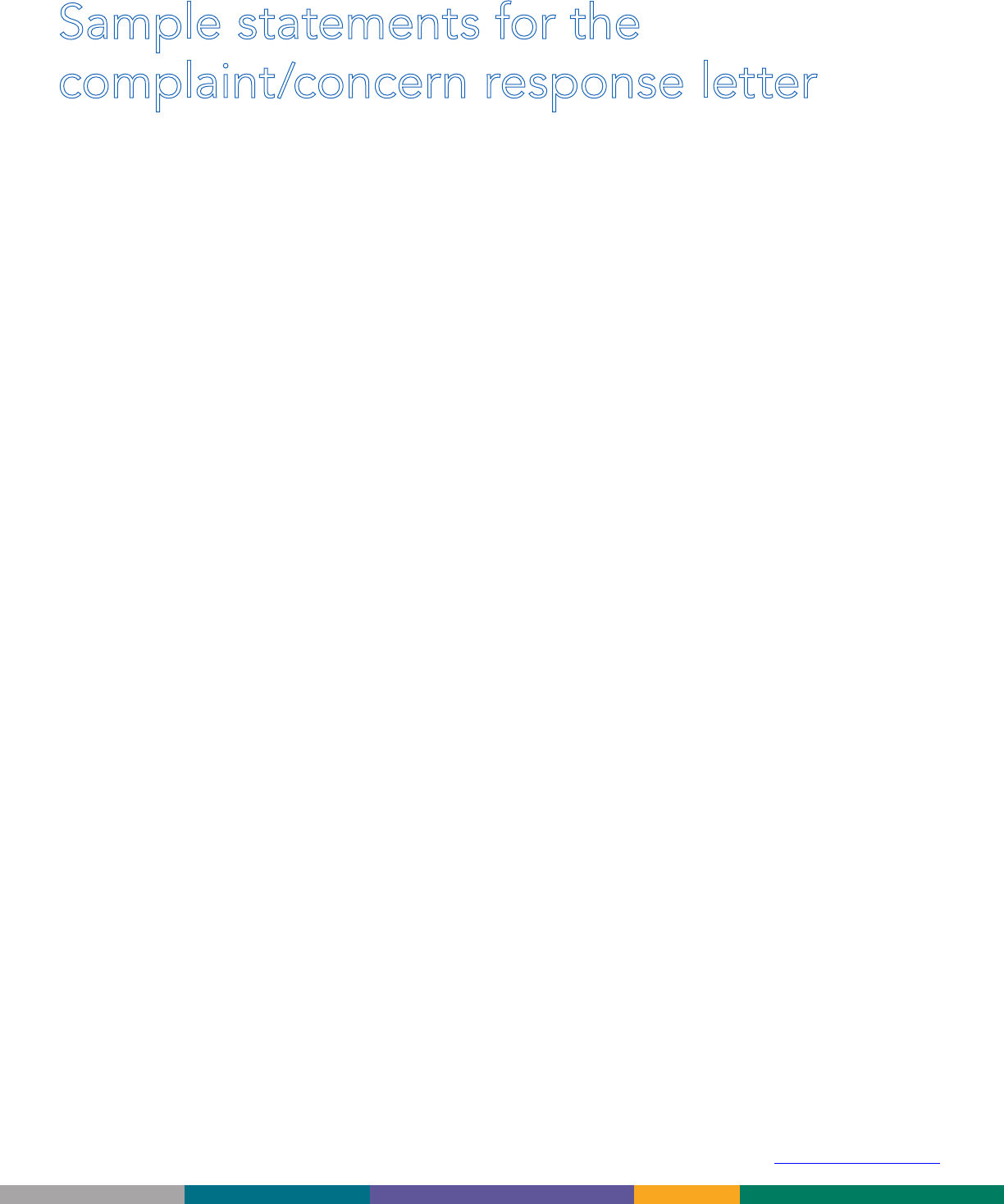
Sample statements for the
complaint/concern response letter
1
Salutation
Thank you for your letter of…regarding/
concerning/in connection with…
We refer to your letter of…about/relating to…
We appreciate your having taken the time to voice
your concerns…
We appreciate your raising your concerns with us…
2
Offer an apology (if appropriate)
early in the letter
We must apologize for…
We sincerely apologize for…
Please accept my/our apologies for…
We would like to apologize
for…
When a loss has occurred:
We would like to offer my/our
condolences to you and/or your family
on the loss of…
Please accept our condolences on the
loss of…
We appreciate that this is a difcult
time for you/your family…
3
Accept the complaint/concern
We agree our usual high standard of service
was not met in this instance…
We clearly did not meet your expectations…
We take these concerns very seriously…
We try to learn from these types of situations
and we thank you for your feedback…or your
feedback will help us improve...
4
Indicate what you have
learned from your review
As a result of our review, we found that...
The problem was the result of…/resulted
from…
The cause of/reason for the situation was…
As a result…
This led to…
Consequently…
When the review has not
been completed:
We are conducting a review…
Our review of this matter is underway…
When our review is complete…
5
If you make changes
because of the situation
that prompted the
complaint, offer solutions
We have modied/changed our...
We have implemented a system to...
To prevent this from happening again
we have set up/implemented a…
6
Express regret for
complaints expressed
We sincerely regret this happened to you…
We are very sorry…
We truly regret the unfortunate
circumstances of your stay…
We understand how disappointing it can be
when your expectations are not met…
7
Conclude the letter and provide
future contact with coordinates
Please do not hesitate to contact me/us…
We are available at…
We can be reached at…
Adapted from How to Reply to Complaints.
9

Get feedback
Expedient complaint/concern handling
may ultimately decrease the risk of
legal action. But before sending the
response, ask a colleague to read
your letter and provide constructive
feedback. Engage risk management or
legal counsel in reviewing responses
to individuals, especially for sensitive
cases including those that may become
a legal claim. And remember, HIROC is
always available to review and provide
feedback on response letters.
A second pair of
eyes on the letter
will mitigate the risk
of having the right
intention but saying it
the wrong way.
10
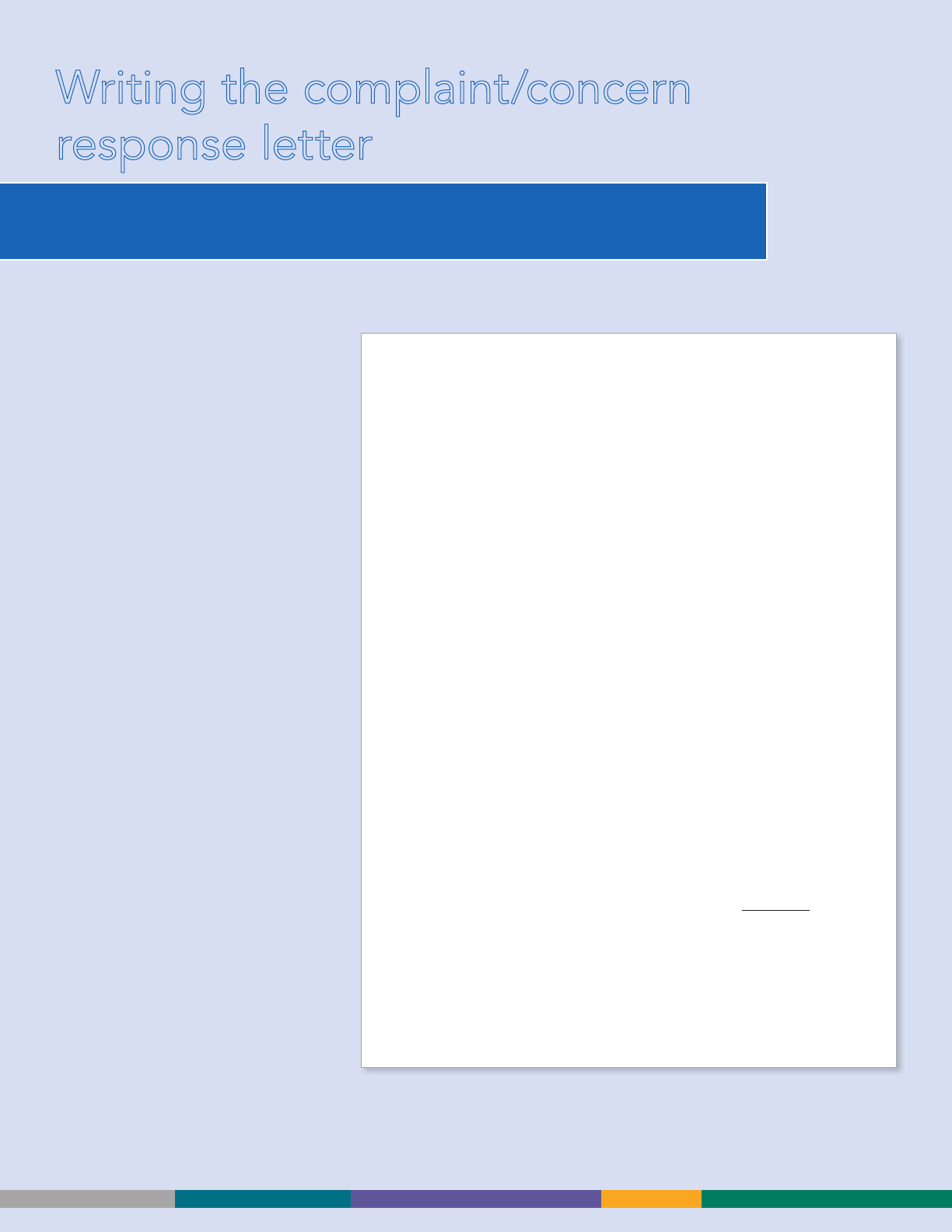
Writing the complaint/concern
response letter
SAMPLE 1 – Letter of complaint/concern
Rebecca White presented to
the emergency department
of her community hospital
with acute back pain of
unknown origin. After triage
and registration, she was
directed to sit in the waiting
room and told the doctor
was busy with a trauma
patient and it would take
a while for her to be seen
as she was a lower priority
than others ahead of her.
On several occasions Mrs.
White approached the
reception desk growing
increasingly frustrated that
she was having to wait.
When she requested pain
medication from the triage
nurse, she was directed
back to the waiting room
and told she would receive
the medication when the
nurse could get to it. Four
hours had passed before
she was nally attended to
by the doctor.
SAMPLE
May 10, 2016
Lisa McDonald
Director, Patient/Family Relations
Dear Ms. McDonald:
re: recent visit to Emergency Department
I feel compelled to write this letter following my recent
experience as a patient in the Emergency Department on
May 7th, 2016. I have had many positive visits to the hospital
previously, but this time, was appalled at being made to wait
for 4 hours before being seen by a doctor. e Triage Nurse
was rude to me and told me that it was a very busy night and I
was “not the priority”. At that time, I was experiencing a lot of
discomfort in my back and having to sit for that length of time
made it even worse. When I approached the front desk to ask
about getting something for the pain, I was told to sit down and
the nurse would “get to it” when she had time.
You advertise your organization as being caring and patient/
family-centred but this is obviously not the case in your
Emergency Department.
I would most certainly appreciate an explanation in writing, of
why things went so wrong and what you plan to do about it.
ank you and I wait to hear from you.
Mrs. R.W. White
11
SAMPLE

12
SAMPLE
June 20, 2016
Dear Mrs. White:
re: recent visit to Emergency Department
ank you for your complaints about our
emergency department. First of all, a four
hour wait in our emergency department is not
unusual. As you may be aware, wait times in our
province are a real problem yet to be resolved.
ere are many hospitals that struggle with the
same issue.
When I spoke to the nurse about being rude
to you, she said that she wasn’t and further
indicated:
• It was a very busy night so she doesn’t
really remember you that well
• You were over-anxious about your pain
• From her assessment she felt you could
wait to get your pain medication
Once again, thank you for writing to us but we
are a very caring and patient/family-centred
hospital. I guess it wasn’t a good experience for
you. at is too bad.
Sincerely,
Lisa McDonald
Director, Patient/Family Relations
SAMPLE 1 – How not to respond
SAMPLE 1 – Suggested response format
SAMPLE
May 20, 2016
Dear Mrs. White:
re: recent visit to Emergency Department
ank you for your letter of May 10, 2016
regarding your recent experience in our
Emergency Department. Clearly our care did not
meet your expectations with a prolonged wait, lack
of courtesy and lack of pain control for your back
pain. For all for this I do sincerely apologize.
I am very sorry to learn of your experience and can
understand how upsetting this has been for you.
I also want to assure you that we take these
concerns very seriously and this is not the patient/
family experience we strive for. We have reviewed
your concerns and have conducted interviews with
the sta who took care of you. I have been advised
there were several patients waiting for care that
evening, some with life-threatening conditions.
Your prolonged wait to see the doctor related to
that patient volume and acuity on that particular
shi. Reducing wait times for all patients/families
in our emergency department is a high priority at
our hospital. We anticipate improvements in future
as we continue to address this concern.
When the Emergency Department nurse manager
spoke with the nurse about her response to you,
the nurse indicated she was regretful of her tone
with you and extends her sincere apologies for not
addressing your pain sooner.
If you have any further concerns about this and
would like to discuss this in-person with myself
or the nurse manager, please contact me at the
number below and I will be happy to arrange a
meeting for you. I am available throughout the day
and am happy to schedule a meeting with you.
Sincerely,
Lisa McDonald
Director, Patient/Family Relations
(Insert contact information)
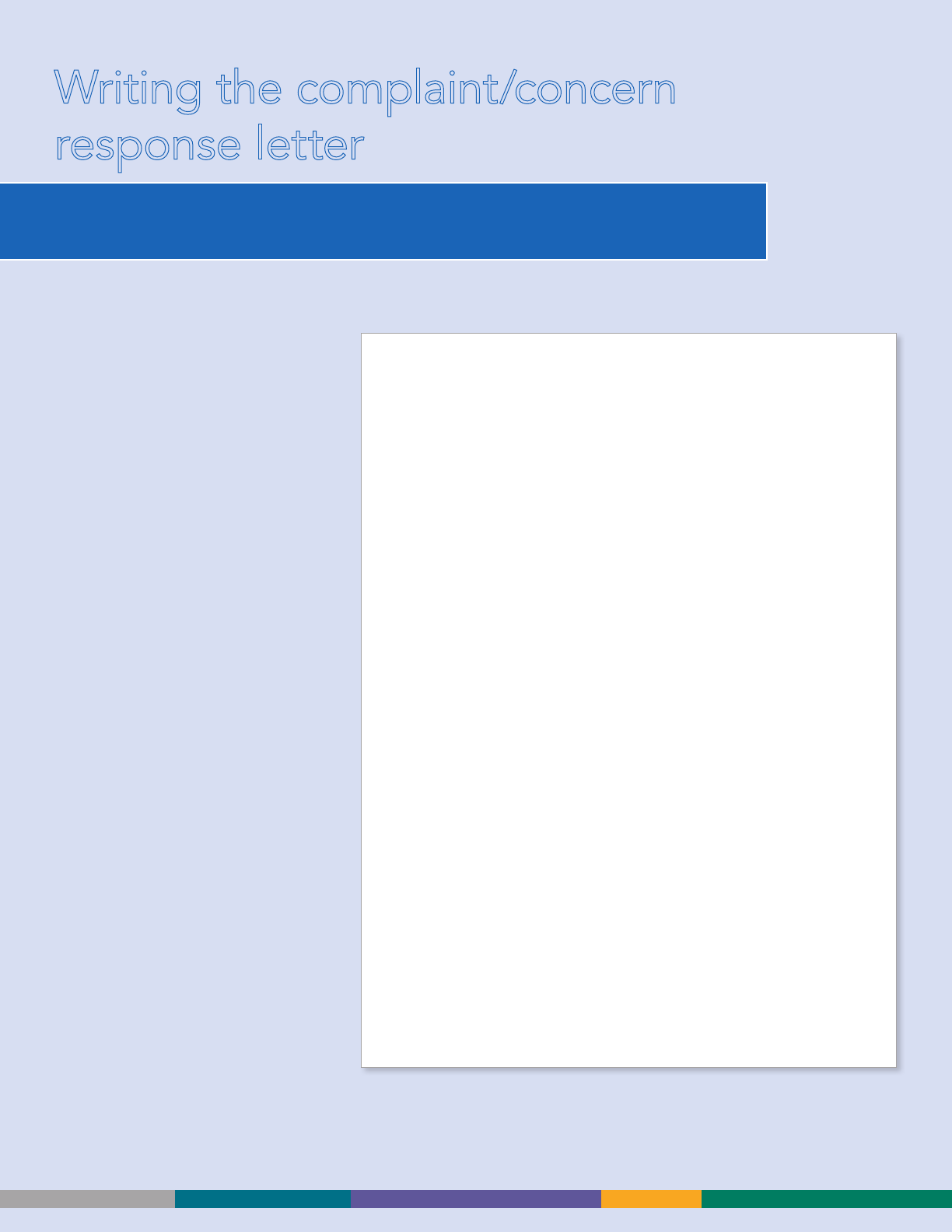
Writing the complaint/concern
response letter
SAMPLE 2 – Letter of complaint/concern
Edith Wilson was admitted
to a medical oor and
diagnosed with sepsis
and pneumonia. Suffering
bouts of confusion and
restlessness, she was
often incontinent. Fall
precautions were put in
place by the nursing staff.
Unfortunately, Mrs. Wilson
still managed to fall out
of her bed, suffering a
catastrophic brain injury.
She subsequently passed
away at the hospital.
This example assumes
that the son is authorized
to receive personal health
information about his
mother. Before writing
responses, always consider
privacy issues and whether
patient information
can be shared with the
complainant.
SAMPLE
SAMPLE
September 23, 2016
To Whom It May Concern,
I am writing on behalf of the family of our 79-year-old mother,
Edith Wilson who passed away at your hospital on August 22nd,
2016 aer a short illness.
She was admitted to the medical oor on July 30th, 2016 with
high blood sugars, a fever and complaints of shortness of breath.
Subsequently, she was diagnosed with sepsis and pneumonia.
In the weeks following her admission, she seemed to be getting
better, but she was quite confused and restless at times. More
than once when Sarah B. was looking aer her, we found her in
a urine-soaked diaper which undoubtedly caused a rash. Our
biggest fear was that she would fall out of bed because she had
to use the bathroom, but we were assured she was in good hands
and would be kept safe. To add insult to injury, her dentures
were misplaced.
On August 1st, 2016 we received a call at 2 in the morning to
tell us our mother had suered a fall and hit her head. She was
transferred to the ICU for the rest of the night but discharged
back to the oor the next day. We were told at that time she was
not likely to recover and we should prepare ourselves for that.
What I need to understand, is why my mother fell given your
sta was well aware of her confusion and restlessness. Your job
was to keep her safe and clearly you failed to do so. I would like
an explanation as to why this happened.
Mr. B. Wilson,
Edith Wilson’ s son
13

SAMPLE
SAMPLE 2 – How not to respond
SAMPLE 2 – Suggested response format
SAMPLE
September 30, 2016
Dear Mr. Wilson
re: complaints about your mother
anks for writing your letter about your mother.
I am sorry she passed away at our hospital. I am
following up on the complaints you expressed in
your letter.
First of all I agree that Sarah B. was not doing
her job by letting your mother sit in a soaked
diaper for a prolonged period of time. e rash
shouldn’t have happened either. I have already
spoken to Sarah B. and she now has a warning
letter on her le. If she doesn’t improve, she may
well lose her job.
I looked into the fall – this probably could have
been prevented from what I read in the incident
report. I have spoken with the sta about this and
discussed where they went wrong. ey clearly
did not do a good job. ey are probably going to
be reviewing their falls assessment protocols and
making sure that this does not happen to other
patients/families.
As for the dentures, it is unfortunate that those
were lost. When I spoke to Tanya L. about leaving
the dentures on the tray, she denied she did that.
She said that she thinks that Mary R. le them on
the tray even though she knows what happens -
the dentures go to the kitchen, and then they get
thrown in the garbage if they don’t notice. Last
year it happened all the time.
anks again,
If you want to talk to me about this, I am
available.
Janet Brown
Director, Medical/Surgical Services
14
September 30, 2016
Dear Mr. Wilson
re: Edith Wilson’s care
ank you for your letter of September 23, 2016. I
appreciate the time you have taken to express all of
your concerns. I am very sorry to hear of the loss
of your mother, Edith Wilson and appreciate this
must be a very dicult time for you and your family
members. Please accept my sincere condolences.
At (INSERT ORGANIZATION) we strive to deliver
the best care to all of our patients all the time and
regret that this was not your experience.
I deeply apologize for our not having met your
expectations of care at our organization and I fully
acknowledge how distressing this must have been
for you.
A review of your concerns regarding your mother’s
nursing care has now been completed.
Your mother fell during the change of shi when
fewer sta was available to monitor your mother’s
activity. e sta explained it was likely related
to her wanting to use the bathroom. Since your
mother’s fall, making more sta available to monitor
the patients during shi change has been fully
implemented and it seems to already be making
a dierence. We have also scheduled refresher
training for all of our sta on falls prevention with
a particular focus on toileting protocols. We are
making every eort to ensure the occurrence of falls
decreases at (insert organization name) and that
patient safety remains a top priority.
I hope that I have been able to answer your
concerns. If you have any further questions, please
contact me at:
Janet Brown
Director, Medical/Surgical Services
(Insert contact information).

Writing the complaint/concern
response letter
SAMPLE 3 – Letter of complaint/concern
James Munroe was
discharged to his son’s
home following a lengthy
stay in hospital for
congestive heart failure.
During the hospitalization,
as an insulin-dependent
diabetic, his blood glucose
levels had been difcult
to stabilize. He also
developed a signicant
pressure ulcer on his right
hip. Mr. Munroe was eager
to return home but because
he lived independently, and
was going to require more
monitoring, his son offered
to have him stay with
him until he adequately
recuperated. Sent home
with homecare nursing
visits for wound care,
Mr. Munroe’s condition
worsened and he was
readmitted to hospital
three weeks later with a
wound infection.
SAMPLE
November 30, 2016
To: Teresa Harrison, Care Coordinator, Community Care
Aer a lengthy stay in the hospital, my elderly father, James Munroe
was discharged to my home on September 2nd, 2016. Aside from
other medical problems, including diabetes, he had a deep pressure
ulcer on his right hip which required follow up home care visits for
dressing changes. It was subsequently arranged that my father would
have nurses visit daily so the wound packing could be changed.
Aer 3 weeks, and many conversations in-between, it was clear to
me the wound was not healing and in fact, it looked worse. e
drainage seemed to be increasing and there was a very foul smell
coming from the wound. e nurses I spoke to told me that this was
pretty normal. I got the sense from them I was not to worry about
it. When my father developed a high fever, I knew something was
denitely not right. is is what prompted my call to his doctor and
subsequently landed him back in hospital. It was there a retained
piece of packing was found in the wound.
My Dad has had to spend another 4 weeks in hospital for antibiotic
therapy and more aggressive wound management. During this
time, his blood sugars have been very hard to control. He has been
frequently disoriented and I was just approached about considering
his placement in a nursing home.
If he does come back home, I need to know I can rely on your
nursing services to take good care of my father. Surely, taking care
of a pressure ulcer is not out of the ordinary. It seems to me the
retained packing caused his deterioration and frankly this should
not have happened. Looking back on this experience, had I not
advocated on my father’s behalf, I’m not convinced any of your sta
would have done so.
Any insights that you can shed on this, I would certainly appreciate.
Regards,
David Munroe
15
SAMPLE

16
SAMPLE
December 7, 2016
Dear Mr. Munroe:
re: James Munroe
It’s really unfortunate your father’s wound
worsened during our watch. We generally have
a pretty solid record when it comes to wound
care and it is a rare occurrence for packing to be
retained. But, it happened and you are probably
right about the fact that the sta was not paying
attention.
I hope your father is doing better and please let
him know we will do a better job when he comes
home. e nursing sta responsible for this will
not be visiting him in the future. In fact, they
are going through some refresher training as we
speak and will be expected to pass a wound care
certication so that no one else gets harmed in
the future.
Don’t judge us on this one experience. We will
look aer your father when he comes home and
you can expect our care to be superb! I will be
making sure of that!
Regards,
Teresa Harrison,
Care Coordinator, Community Care
SAMPLE 3 – How not to respond
SAMPLE 3 – Suggested response format
SAMPLE
December 7, 2016
Dear Mr. Munroe:
re: James Munroe
I am following up about your letter of November
20th, 2016 and our subsequent conversation about
your father’s care on November 21st, 2016. At that
time you stated you would like a reply in writing to
your concerns raised.
I would like to reiterate our deep regret that your
father was re-hospitalized due to the wound
infection. I do realize what a stressful time this has
been for him as well as you. I also agree that our
usual high standard of service was not met in this
instance. We have spent considerable time discussing
the circumstances to clearly understand what led to
the retained packing and why your concerns were
not acted upon.
Upon review I have learned that the nurses were
not consistently recording the packing removed
or inserted in the wound. We have subsequently
reviewed our expectations in respect to this and have
implemented a revised protocol for wound care.
Subsequent wound care refresher training has now
been completed by our sta.
In respect to the several opportunities to react
sooner to your father’s deteriorating wound, I assure
you the sta is regretful they were not more attentive
to your concerns and for that we are truly sorry. We
are doubling our eorts to improve communication
with our patients and families. I anticipate improved
responses in future.
I understand your condence in our service has
been eroded but do hope this provides you with
some reassurance that we will continue to strive to
do better in the provision of care to your father upon
his return to your home. Should you need to contact
me further, I can be reached at 476-432-7732 or at
With respect,
Teresa Harrison,
Care Coordinator,
Community Care

Writing a complaint/concern response
letter to a challenging individual
A careful response is required when dealing with an aggressive, prolonged or intractable complaint.
Consider concisely addressing the following:
• complaints/concerns raised;
• complaints/concerns investigated and explanations for any that were not;
• decisions/outcomes reached;
• the nature and/or number of interactions between the individual and the organization;
• example(s) of the unreasonable behaviour engaged in by the individual;
• a statement and explanation about how further communications relating to the
complaint will be dealt with.
Furthermore, ensuring the response letter is signed by someone in a position of authority (preferably the
CEO) will clarify that the complaints/concerns have been escalated and considered at the highest level of
the organization. (Barbour, 2012)
Final Thoughts
Responding to complaints/concerns is more
of an art than a science. The letter presents an
opportunity to provide acknowledgement to
an individual and for the organization to learn
from what went wrong. It requires adequate
time, patience and attention to ensure a
concerned and measured approach so that
individuals feel they have been heard and
listened to.
The useful and practical information within
this guide is intended to enhance your letter-
writing skill and strengthen your responses
and ultimately, to meet the needs of
individuals who have taken the time to share
their experience with you. The hoped-for
result is delivering the intended message in a
manner reective of a caring and professional
organization.
17

Additional Resources
1. Beacham J. (2015). How to deal with patient/family complaints. Hospital Care, Workplace Issues.
2. Barbour B. (2012). Managing unreasonable complainant conduct: A manual for frontline staff, supervisors and
senior managers (2nd Ed.). Practice Manual.
3. Canadian Patient Safety Institute. (2011). Canadian disclosure guidelines: Being open with patients and families.
4. Excellent Care for All Act, Statutes of Ontario. (2010, c.14).
5. Montini A, Noble A, Stelfox H T. (2008). Content analysis of patient/family complaints. Int J Qual Health Care.
20(6): 412–420.
6. Roberts R. (2007). The art of apology: When and how to seek forgiveness. Fam Prac Manag. 14(7): 44-49.
7. Southern Health NHS Foundation Trust. (2010). An informal guide to: Writing complaint responses.
8. Treanor J. (2014). How to Develop Better Practice in Response to Patient Complaints. Nurs Manag. 21(1): 22-27.
9. Yoder-Wise P S. (2015). Patient/family complaints: Not ours to own, but ours to x. J Contin Educ Nurs. 46(12):
531-532.
18

Head Ofce
4711 Yonge St, Suite 1600, Toronto, ON M2N 6K8
Tel: 416.733.2773 Fax: 416.733.2438
Toll Free: 1.800.465.7357 Fax: 1.800.668.6277
Western Region
1200 Rothesay St., Winnipeg, MB R2G 1T7
Tel: Tel: 204.943.4125 Fax: 204.949.0250
Toll Free: 1.800.442.7751
westernregion@hiroc.com
HIROC is Canada’s leading provider of healthcare liability insurance. As a not-for-prot,
we partner with our subscribers to provide innovative insurance and risk management
solutions that help them reduce risk, prevent losses and improve patient safety.
www.hiroc.com
